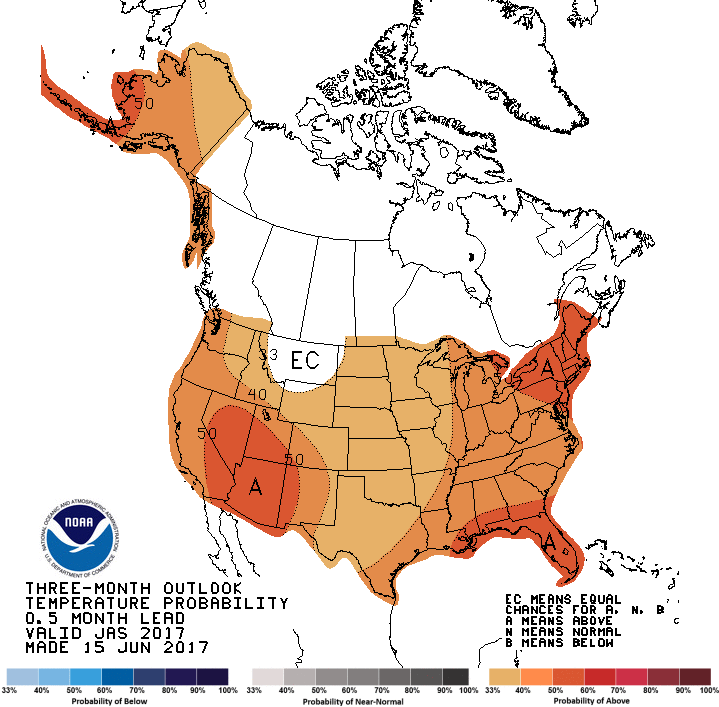7 Tips for Keeping Cool This Summer — Without Spending a Fortune
July 3, 2017 by Paul AusickAccording to the National Oceanic and Atmospheric Administration (NOAA), most of the Lower 48 states can expect higher than normal temperatures this summer. The Southwest, Florida and the Gulf Coast all the way to New Orleans, and the Northeast have 50% to 60% chance of seeing higher than normal temperatures.
In the most of the Midwest, the outlook forecasts a 33% to 40% chance of warmer temperatures, while the West Coast and most of the country east of the Mississippi River has a 40% to 50% chance of seeing above-normal temperatures. The only place where temperatures are predicted to be normal is Montana. The NOAA forecast for the summer is included at the end of this story.
The higher temperatures will, of course, raise demand for air conditioning, which raises demand for electricity and results in higher electricity bills for many Americans. But there are some simple steps you can take to keep those bills from becoming a burden.
Perhaps the single most effective step to keeping that electric bill manageable is to set the thermostat a little higher. According to the experts at Trulia.com, every degree you raise the thermostat yields a 7% to 10% savings on the cost of cooling your home.
Here are seven more steps you can take to save more:
Keep windows closed and covered during the day. Block the heat and sunlight from getting into your home, especially if no one is home during the day. If the house has shutters, close those too.
Open windows at night. Take advantage of the natural night-time cooling to let the cool air in at night. Then remember to close the windows to trap it inside.
Use a ceiling fan. Set the fan to rotate counterclockwise in the summer to produce a breeze that can make a room feel eight degrees cooler. Running a fan is cheaper than running the a/c.
Avoid using heat-generating appliances. Running the clothes dryer and cooking can generate excess heat. It’s not always possible to avoid using these appliances, but a fan in the laundry room and a hood fan over the stove can help.
Run the air-conditioning unit less. Use the air conditioner only when you’re home and only when you have no alternative.
Install a smart thermostat. The U.S. Department of Energy reckons that annual savings from using one of these can run to 5% to 15% of heating and cooling bills. If you don’t already have a programmable thermostat, that’s a good intermediate step.
Get an energy-use inspection. Many utility companies will do this for no charge. Heating and cooling account for about 40% of your home’s energy costs, so any changes you make here can have a big impact on your monthly bills.
Here’s the NOAA summer heat forecast map.

Sponsored: Want to Retire Early? Here’s a Great First Step
Want retirement to come a few years earlier than you’d planned? Or are you ready to retire now, but want an extra set of eyes on your finances?
Now you can speak with up to 3 financial experts in your area for FREE. By simply clicking here you can begin to match with financial professionals who can help you build your plan to retire early. And the best part? The first conversation with them is free.
Click here to match with up to 3 financial pros who would be excited to help you make financial decisions.